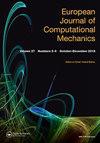Analysis of the Mechanical Characteristics of Tunnels Under the Coupling Effect of Submarine Active Faults and Ground Vibrations
IF 0.6
Q3 MECHANICS
引用次数: 0
Abstract
With the rapid development of modern transportation construction, the construction of cross-harbor tunnels has solved the problem of traffic connection between cross-straits, bays and islands. The construction of sub-sea tunnels has technical difficulties such as high difficulty of marine geological survey, close hydraulic connection between strata and seawater, and more developed adverse geology. Based on this, this paper studies the mechanical characteristics of the submarine tunnel under seismic action at the active fault. Firstly, the mechanical model of the universal fault interface is established, and the calculation model of the fault interface is theoretically derived by the method of vibration mechanics, and the influence of the change of the strength of the contact surface and the stiffness of the surrounding rock on both sides of the fault on the transfer coefficient is obtained. Secondly, based on the ground motion input method of two-dimensional homogeneous half-space field, the relevant program of viscoelastic artificial boundary ground motion input is written by MATLAB program, which lays the foundation and premise of load input for mechanical response calculation. Finally, the outcomes of the tunnel parameters and the interplay between the tunnel and the surrounding rock on the cracking of the tunnel lining shape and the mechanical response of the cross-fault sub-sea tunnel underneath seismic motion are mentioned, and it is concluded that the increase in seismic intensity for different seismic intensities under the sea floor has an essentially constant proportion to the increase in acceleration of the seismic response; the seepage effect under the sea floor for the tunnel lining structure reduces the seismic response displacement, velocity and The seabed seepage for the tunnel lining structure reduces the peak seismic response displacement, velocity and acceleration by about 20–35%.海底活动断层与地面振动耦合作用下隧道力学特性分析
随着现代交通建设的迅速发展,跨海隧道的建设解决了海峡两岸、海湾与岛屿之间的交通连接问题。海底隧道施工存在海洋地质调查难度大、地层与海水水力联系紧密、不利地质条件较发达等技术难点。在此基础上,研究了海底隧道在活动断层地震作用下的力学特性。首先,建立了通用断层界面的力学模型,利用振动力学的方法对断层界面的计算模型进行了理论推导,得到了断层两侧接触面强度和围岩刚度变化对传递系数的影响;其次,基于二维均匀半空间场地震动输入方法,通过MATLAB程序编写了粘弹性人工边界地震动输入的相关程序,为力学响应计算的载荷输入奠定了基础和前提。最后,讨论了隧道参数及隧道与围岩的相互作用对海底跨断层隧道衬砌形状开裂和地震作用下的力学响应的影响,得出海底不同烈度地震作用下的地震烈度增加与地震响应加速度增加的比例基本恒定的结论;海底渗流作用使隧道衬砌结构的地震响应位移、速度和加速度峰值降低约20-35%。
本文章由计算机程序翻译,如有差异,请以英文原文为准。
求助全文
约1分钟内获得全文
求助全文

 求助内容:
求助内容: 应助结果提醒方式:
应助结果提醒方式:


